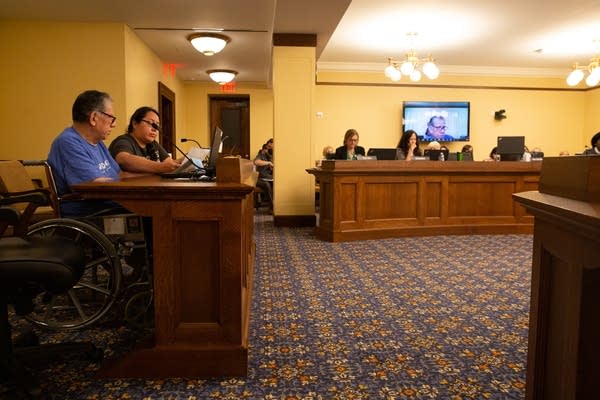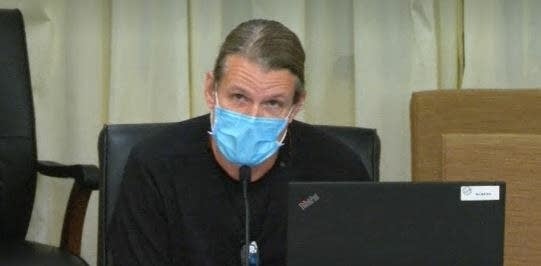Pandemic pay panel inches toward agreement

Go Deeper.
Create an account or log in to save stories.
Like this?
Thanks for liking this story! We have added it to a list of your favorite stories.
In late July, nurse Brian Splatt went before state officials with a firsthand account of personal risks faced by health workers during the COVID-19 pandemic.
He was among those who tended to patients in isolation and stretched the use of protective equipment. He pulled 12-hour overnight shifts in the Minnesota Masonic Home COVID unit.
“When my shift was done, I would shower and then sleep on the unit for four days to try to reduce the risk to my family,” Splatt told the group of lawmakers and state agency commissioners. “When I did leave the facility, I would shower and have all my dirty scrubs double plastic bagged to reduce the risk of viral spread into our home.”

The Frontline Worker Pay Working Group heard dozens of stories like that. The nine-person task force was formed to recommend who should share in special pay from a $250 million fund.
Turn Up Your Support
MPR News helps you turn down the noise and build shared understanding. Turn up your support for this public resource and keep trusted journalism accessible to all.
Two months after Splatt testified, he and the rest are still waiting on word. But he’s willing to cut those making the decisions some slack.
“What I went through, I definitely believe we deserve — the long-term care facilities — deserve a piece of the pie for sure,” Splatt said in a telephone interview. “But to be 100 percent honest, I heard all that testimony and it also moved me from all these other people — from the custodians and the meat packers and everybody, right? The grocery store workers, I do understand that.”
Although they missed an early September deadline for finalizing a plan, the lead working group members say they’re zeroing in on agreement.
DFL House Majority Leader Ryan Winkler, who chairs the panel, said a rough outline would provide compensation for up to 670,000 critical workers who powered through amid uncertainty or worse. But the size of their bonuses still hasn’t been finalized.
“We could also look at providing two different groupings where some workers get a set dollar amount and others get a bit more if they were engaged in caring for patients and at particularly high risk,” Winkler said, adding that it’s not his favored option.
Vice Chair Karin Housley, a Republican state senator, said that’s the approach that makes the most sense to her.
“We don’t want to devalue anybody who stepped up and went to work. Everybody needs to be commended,” Housley said.
But she added, “When you go to work and you know COVID is in your building, when you know you’ll be face-to-face with somebody with COVID. You could be taking care of somebody who is dying from COVID. You’re wearing two masks and full PPE. There definitely is increased risk.”
The total pool of recipients will also depend on how many in the qualifying sectors served in an in-person capacity. Those who did their jobs from home or collected benefits through other programs probably wouldn’t be eligible, according to working group members.
The panel is set to meet as soon as next week to consider recommendations that would then go to the Legislature. But a special session won’t be called until Gov. Tim Walz and key legislators agree on an agenda.
Walz also wants approval of a farm aid package and agreement from Senate Republicans that they won’t fire more agency commissioners or force votes on vaccine-related legislation — promises they have yet to make.
The final pay deal will no doubt upset some who sought a share, Walz said last week.
“There is absolutely no way that there’s not going to be blowback, that this isn’t enough people covered or the dollar amount isn’t as much,” Walz said. “But this is the perfect getting in the way of the good.”
Besides, he said, lawmakers could decide next year to approve additional payments. Republicans, including Housley, said it’s possible that Walz could supplement the pool of available money from a $500 million set-aside of federal aid that lawmakers gave him full discretion over.
Housley said she’s confident the working group can find consensus; where it goes from there is up to others, she said. Winkler said it’s hard to view this issue in isolation.
“It’s not the numbers, it’s not the merits. I think we can reach an agreement on the merits” of a pandemic pay program, Winkler said. “I think it’s the broader vaccine politics and politics of who is going to be the next Republican nominee for governor that’s getting in the way.”
Once there is legislative signoff, Revenue Commissioner Robert Doty said a process of identifying specific workers, verifying eligibility and distributing the money would ramp up. Internal planning has already begun, he said, with a goal of providing money in this calendar year.
It’s unclear whether state agencies like Doty’s will have full operational control over the distribution or if it will flow through a third-party vendor or an employer-grant system. Doty favors having agencies take a prominent role to ensure accountability, but he’s not opposed to contracting with a firm to get money out the door faster.
"We all feel a very huge sense of responsibility to get this right and to get those payments out as quickly as possible," Doty said.
Housley said she hopes the turnaround can be weeks, not months.
“I want to get these checks out so people can be spending them before the holidays,” she said.
Meanwhile, Splatt is back to eight-hour shifts at his facility, where COVID-19 has been kept at bay in recent months due to precautions and vaccination among patients and staff. But he is still ready to hit the front lines again, if necessary.
“If we get a COVID-positive patient and we open up the isolation wing, it’ll be the same thing,” Splatt said. “It’ll be 12 hours for the day and 12 hours for the night. And they know that I’m willing to go back down there. I’m one of the first on the list.”


